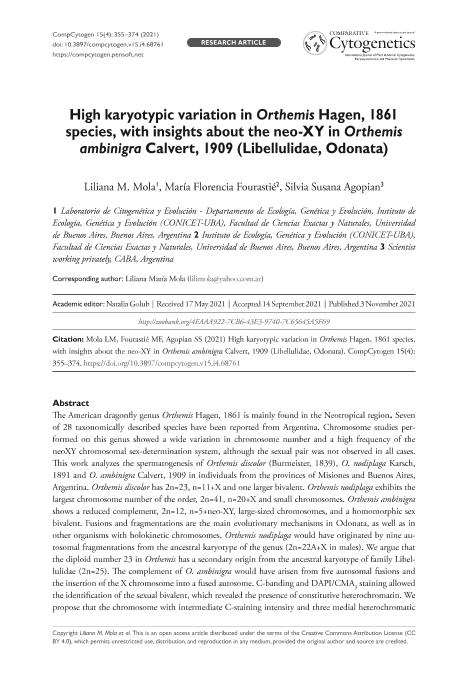Mostrar el registro sencillo del ítem
dc.contributor.author
Mola, Liliana Maria

dc.contributor.author
Fourastié, María Florencia

dc.contributor.author
Agopian, Silvia Susana
dc.date.available
2022-12-21T19:29:25Z
dc.date.issued
2021-05
dc.identifier.citation
Mola, Liliana Maria; Fourastié, María Florencia; Agopian, Silvia Susana; High karyotypic variation in Orthemis Hagen, 1861 species, with insights about the neo-XY in Orthemis ambinigra Calvert, 1909 (Libellulidae, Odonata); Zoological Institute; Comparative Cytogenetics; 15; 4; 5-2021; 355-374
dc.identifier.issn
1993-0771
dc.identifier.uri
http://hdl.handle.net/11336/182094
dc.description.abstract
The American dragonfly genus Orthemis Hagen, 1861 is mainly found in the Neotropical region. Seven of 28 taxonomically described species have been reported from Argentina. Chromosome studies performed on this genus showed a wide variation in chromosome number and a high frequency of the neoXY chromosomal sex-determination system, although the sexual pair was not observed in all cases. This work analyzes the spermatogenesis of Orthemis discolor (Burmeister, 1839), O. nodiplaga Karsch, 1891 and O. ambinigra Calvert, 1909 in individuals from the provinces of Misiones and Buenos Aires, Argentina. Orthemis discolor has 2n=23, n=11+X and one larger bivalent. Orthemis nodiplaga exhibits the largest chromosome number of the order, 2n=41, n=20+X and small chromosomes. Orthemis ambinigra shows a reduced complement, 2n=12, n=5+neo-XY, large-sized chromosomes, and a homomorphic sex bivalent. Fusions and fragmentations are the main evolutionary mechanisms in Odonata, as well as in other organisms with holokinetic chromosomes. Orthemis nodiplaga would have originated by nine autosomal fragmentations from the ancestral karyotype of the genus (2n=22A+X in males). We argue that the diploid number 23 in Orthemis has a secondary origin from the ancestral karyotype of family Libellulidae (2n=25). The complement of O. ambinigra would have arisen from five autosomal fusions and the insertion of the X chromosome into a fused autosome. C-banding and DAPI/CMA3 staining allowed the identification of the sexual bivalent, which revealed the presence of constitutive heterochromatin. We propose that the chromosome with intermediate C-staining intensity and three medial heterochromatic regions corresponds to the neo-Y and that the neo-system of this species has an ancient evolutionary origin. Moreover, we discuss on the mechanisms involved in the karyotypic evolution of this genus, the characteristics of the neo sex-determining systems and the patterns of heterochromatin distribution, quantity and base pair richness.
dc.format
application/pdf
dc.language.iso
eng
dc.publisher
Zoological Institute

dc.rights
info:eu-repo/semantics/openAccess
dc.rights.uri
https://creativecommons.org/licenses/by/2.5/ar/
dc.subject
CHROMOSOMAL EVOLUTION
dc.subject
HETEROCHROMATIN CHARACTERIZATION
dc.subject
HOLOKINETIC CHROMOSOMES
dc.subject
SEX-DETERMINATION SYSTEM
dc.subject.classification
Genética y Herencia

dc.subject.classification
Ciencias Biológicas

dc.subject.classification
CIENCIAS NATURALES Y EXACTAS

dc.title
High karyotypic variation in Orthemis Hagen, 1861 species, with insights about the neo-XY in Orthemis ambinigra Calvert, 1909 (Libellulidae, Odonata)
dc.type
info:eu-repo/semantics/article
dc.type
info:ar-repo/semantics/artículo
dc.type
info:eu-repo/semantics/publishedVersion
dc.date.updated
2022-09-28T16:27:58Z
dc.identifier.eissn
1993-078X
dc.journal.volume
15
dc.journal.number
4
dc.journal.pagination
355-374
dc.journal.pais
Rusia

dc.journal.ciudad
San Petersburgo
dc.description.fil
Fil: Mola, Liliana Maria. Universidad de Buenos Aires. Facultad de Ciencias Exactas y Naturales. Departamento de Ecología, Genética y Evolución. Laboratorio de Citogenética y Evolución; Argentina. Consejo Nacional de Investigaciones Científicas y Técnicas; Argentina
dc.description.fil
Fil: Fourastié, María Florencia. Universidad de Buenos Aires. Facultad de Ciencias Exactas y Naturales. Departamento de Ecología, Genética y Evolución; Argentina. Consejo Nacional de Investigaciones Científicas y Técnicas; Argentina
dc.description.fil
Fil: Agopian, Silvia Susana. Universidad de Buenos Aires. Facultad de Ciencias Exactas y Naturales. Departamento de Ecología, Genética y Evolución. Laboratorio de Citogenética y Evolución; Argentina
dc.journal.title
Comparative Cytogenetics

dc.relation.alternativeid
info:eu-repo/semantics/altIdentifier/doi/http://dx.doi.org/10.3897/compcytogen.v15.i4.68761
dc.relation.alternativeid
info:eu-repo/semantics/altIdentifier/url/https://compcytogen.pensoft.net/article/68761/
Archivos asociados
